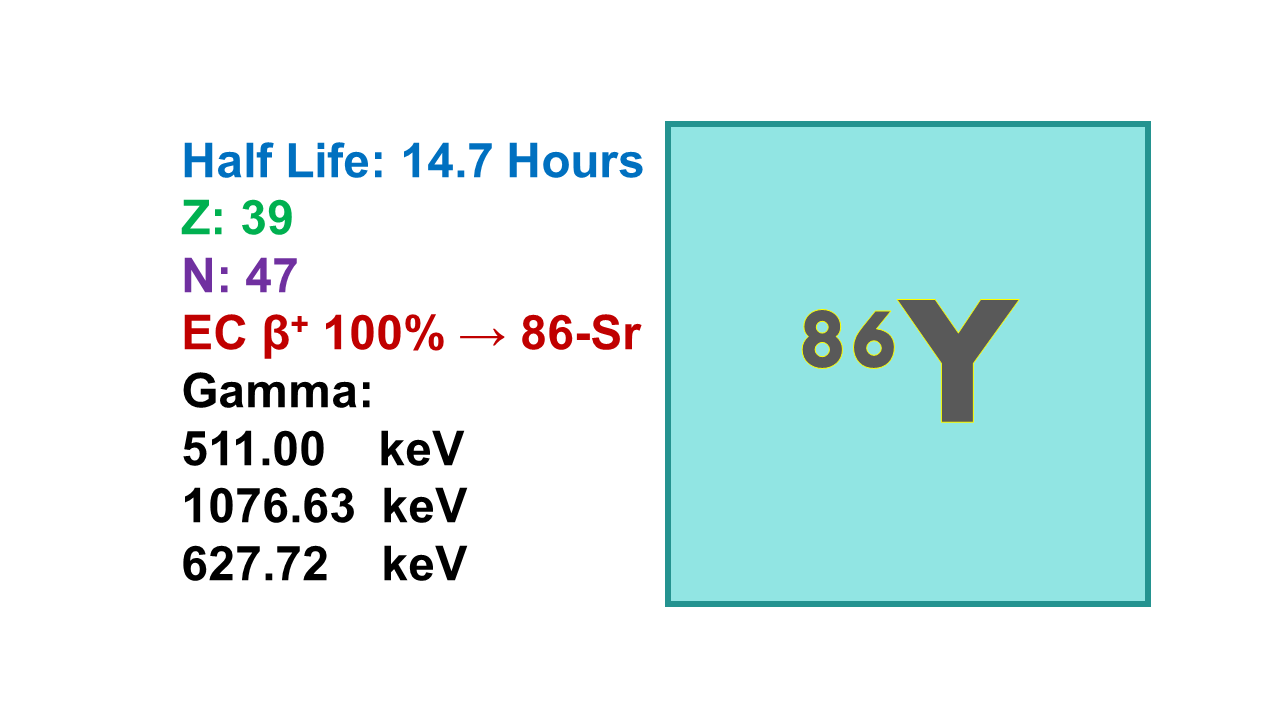
Yttrium-86 (86Y)
February 26, 2024
Yttrium-86 (86Y) is a radioactive isotope of yttrium, a rare earth metal. It has a half-life of 14.74 hours and decays by emitting positrons, which are positively charged electrons. This decay process is known as beta-plus decay.
86Y is commonly used in medical imaging applications, particularly in positron emission tomography (PET) imaging. In PET imaging, a radiopharmaceutical containing 86Y is injected into the body, where it accumulates in tissues or organs of interest. The emitted positrons interact with electrons in the body, leading to the production of gamma rays. These gamma rays are detected by a PET scanner, which creates detailed images that provide information about the metabolic activity and function of the tissues or organs being studied.
The short half-life of 86Y allows for imaging studies to be performed relatively quickly, minimizing radiation exposure to the patient. Additionally, the decay of 86Y into stable strontium-86 makes it a safe and effective radiotracer for use in medical imaging procedures.
Properties:
Yttrium-86 (86Y) is a radionuclide with a half-life of 14.74 hours decaying into stable strontium-86 emitting positrons inter alia at 1,077 keV (83%), 628 keV (33%), 1,153 keV (31%), 777 keV (22%) and 1,920 keV (21% up to 3,141 keV, average energy at 650 keV), but also betas at 1,409 keV (14.2%), 2,243 keV (12.9%) and 1,220 (11.9%). In other words, 86Y is not a really clean PET imaging radionuclide.
Manufacturing:
86Y can be produced by a cyclotron using the route [86Sr(p,n)86Y] at an energy of about 10–15 MeV. Another possible route is by helium-3 irradiation of natural rubidium [natRb(3He,n)86Y], but the availability of the tool able to perform this irradiation is very limited. At energies higher than 30 MeV, reactions on 88Sr [88Sr(p,3n)86Y] or natural strontium with deutons [natSr(d,x)86Y] are also possible. The preferred route of production remains the low-energy cyclotron with 86Sr.
Source and availability:
Although any cyclotron able to produce 18F could produce 86Y providing it is equipped with the right target, today only research cyclotrons produce this radionuclide. The development of 86Y-labeled compounds was stopped at early clinical stages due to the limited interest of investors.
Derivatives:
Only a few 86Y-labeled compounds have reached the clinical level and most of them only because the equivalent 90Y-labeled molecule needed an easy imaging counterpart. 86Y was supposed to become the privileged PET partner of 90Y, but for all molecules that reached the market, the equivalent 111In-labeled SPECT compound was preferred. There is no real future for 86Y in nuclear medicine.
Price:
There is no real market price for 86Y as most of the doses required by research centers are produced by these same research centers. A dose of 86Y costs presently the price of the whole batch production, between EUR 2,000 and EUR 3,000 (US$ 2,200–3,300).
Issues:
- Long half-life and emission of parallel beta.
- Too high-energy of positron emission impacting the quality of the PET images.
- High dosimetry to the patient.
- Limited sources.
Comments:
For a while 86Y was considered as the complementary diagnostic radionuclide for the pure beta emitter 90Y. From a simple development and regulatory point of view, it is much easier to work with a radionuclide that has both gamma and beta emission. 90Y replaced 131I in radiotherapeutics for its physical properties, but 177Lu is now considered as a better alternative to 90Y, leaving 86Y as an orphan diagnostic radionuclide. In fact, the high energy of the 86Y gammas is also not favorable and despite a good chemistry profile (same chelators as other metals), 86Y has lost all its interest.
There are no 86Y-labeled tracers under clinical or preclinical development.